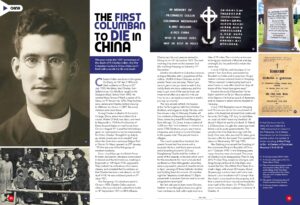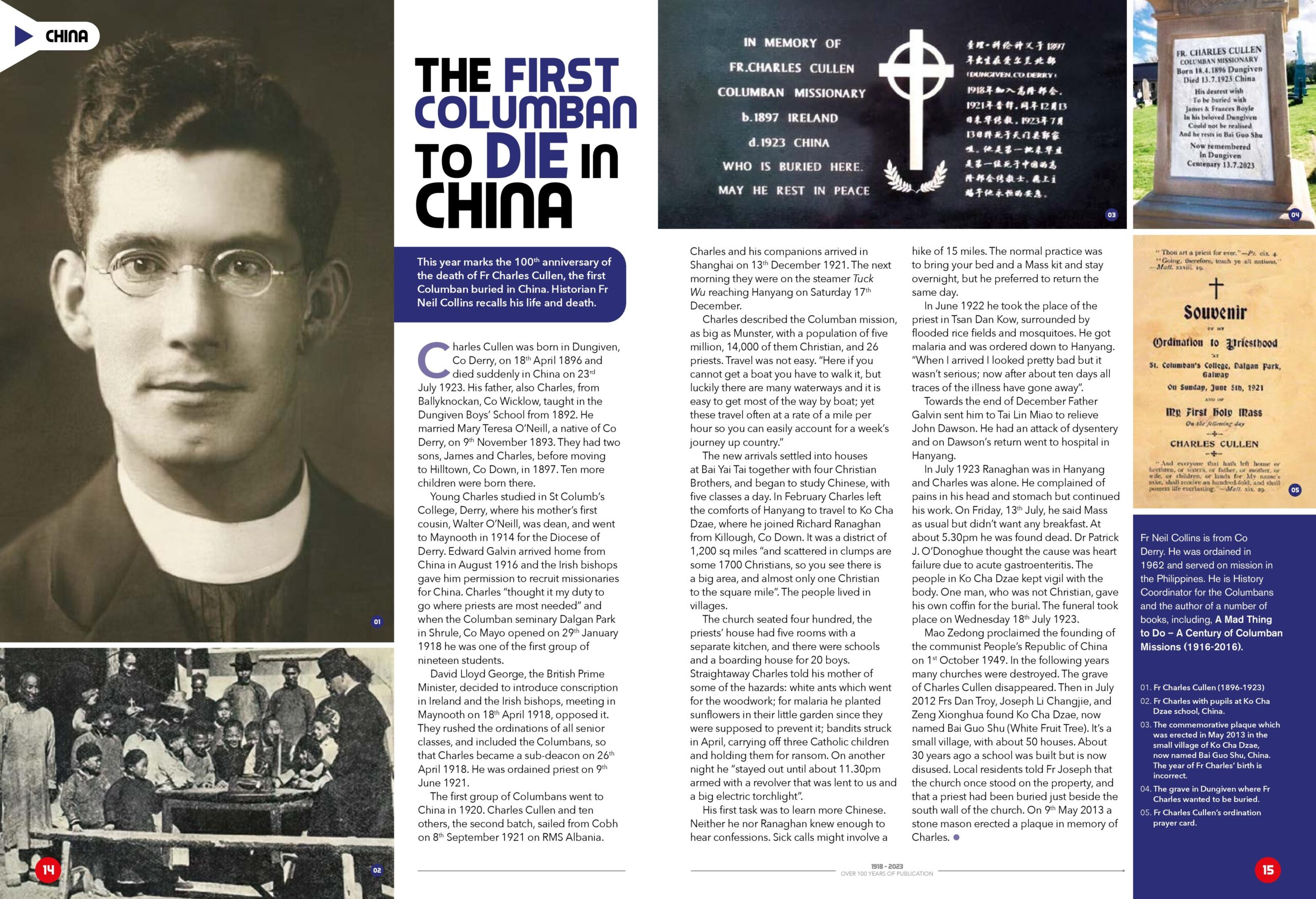This year marks the 100th anniversary of the death of Fr Charles Cullen, the first Columban buried in China. On 13th July, the family of Fr Charles will commemorate the centenary of his death with Mass in Dungiven, Co Derry. Members of the Columbans in Ireland and China will attend that special commemoration with Fr Charles’ family. In the current issue of the Far East magazine, Columban historian Fr Neil Collins recalls Fr Charles’ life and death.
Charles Cullen was born in Dungiven, Co Derry, on 18th April 1896 and died suddenly in China on 23rd July 1923. His father, also Charles, from Ballyknockan, Co Wicklow, taught in the Dungiven Boys’ School from 1892. He married Mary Teresa O’Neill, a native of Co Derry, on 9th November 1893. They had two sons, James and Charles, before moving to Hilltown, Co Down, in 1897. Ten more children were born there.
Young Charles studied in St Columb’s College, Derry, where his mother’s first cousin, Walter O’Neill, was dean, and went to Maynooth in 1914 for the Diocese of Derry. Edward Galvin arrived home from China in August 1916 and the Irish bishops gave him permission to recruit missionaries for China.
Charles “thought it my duty to go where priests are most needed” and when the Columban seminary Dalgan Park in Shrule, Co Mayo opened on 29th January 1918 he was one of the first group of nineteen students.
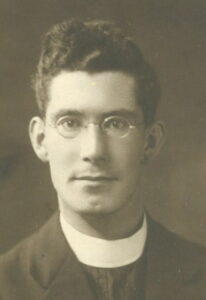
Fr Charles Cullen (1896-1923)
David Lloyd George, the British Prime Minister, decided to introduce conscription in Ireland and the Irish bishops, meeting in Maynooth on 18th April 1918, opposed it. They rushed the ordinations of all senior classes, and included the Columbans, so that Charles became a sub-deacon on 26th April 1918. He was ordained priest on 9th June 1921.
The first group of Columbans went to China in 1920. Charles Cullen and ten others, the second batch, sailed from Cobh on 8th September 1921 on RMS Albania. Charles and his companions arrived in Shanghai on 13th December 1921. The next morning they were on the steamer Tuck Wu reaching Hanyang on Saturday 17th December.
Charles described the Columban mission, as big as Munster, with a population of five million, 14,000 of them Christian, and 26 priests. Travel was not easy. “Here if you cannot get a boat you have to walk it, but luckily there are many waterways and it is easy to get most of the way by boat; yet these travel often at a rate of a mile per hour so you can easily account for a week’s journey up country.”
The new arrivals settled into houses at Bai Yai Tai together with four Christian Brothers, and began to study Chinese, with five classes a day. In February Charles left the comforts of Hanyang to travel to Ko Cha Dzae, where he joined Richard Ranaghan from Killough, Co Down. It was a district of 1,200 sq miles “and scattered in clumps are some 1700 Christians, so you see there is a big area, and almost only one Christian to the square mile”. The people lived in villages.
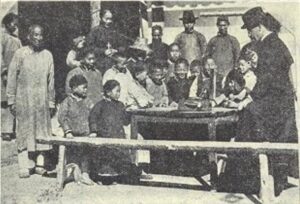
Fr Charles with pupils at Ko Cha Dzae school, China.
The church seated four hundred, the priests’ house had five rooms with a separate kitchen, and there were schools and a boarding house for 20 boys. Straightaway Charles told his mother of some of the hazards: white ants which went for the woodwork; for malaria he planted sunflowers in their little garden since they were supposed to prevent it; bandits struck in April, carrying off three Catholic children and holding them for ransom. On another night he “stayed out until about 11.30pm armed with a revolver that was lent to us and a big electric torchlight”.
His first task was to learn more Chinese. Neither he nor Ranaghan knew enough to hear confessions. Sick calls might involve a hike of 15 miles. The normal practice was to bring your bed and a Mass kit and stay overnight, but he preferred to return the same day.
In June 1922 he took the place of the priest in Tsan Dan Kow, surrounded by flooded rice fields and mosquitoes. He got malaria and was ordered down to Hanyang. “When I arrived I looked pretty bad but it wasn’t serious; now after about ten days all traces of the illness have gone away”.
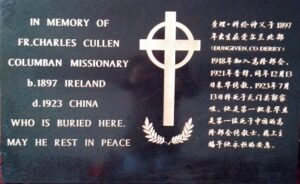
The commemorative plaque which was erected in May 2013 in the small village of Ko Cha Dzae, now named Bai Guo Shu, China. The year of Fr Charles’ birth is incorrect.
Towards the end of December Father Galvin sent him to Tai Lin Miao to relieve John Dawson. He had an attack of dysentery and on Dawson’s return went to hospital in Hanyang.
In July 1923 Ranaghan was in Hanyang and Charles was alone. He complained of pains in his head and stomach but continued his work. On Friday, 13th July, he said Mass as usual but didn’t want any breakfast. At about 5.30pm he was found dead.
Dr Patrick J. O’Donoghue thought the cause was heart failure due to acute gastroenteritis. The people in Ko Cha Dzae kept vigil with the body. One man, who was not Christian, gave his own coffin for the burial. The funeral took place on Wednesday 18th July 1923.
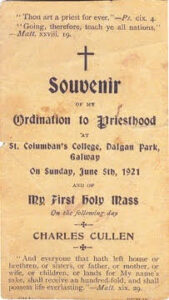
Fr Charles Cullen’s ordination prayer card.
Mao Zedong proclaimed the founding of the communist People’s Republic of China on 1st October 1949. In the following years many churches were destroyed. The grave of Charles Cullen disappeared. Then in July 2012 Frs Dan Troy, Joseph Li Changjie, and Zeng Xionghua found Ko Cha Dzae, now named Bai Guo Shu (White Fruit Tree).
It’s a small village, with about 50 houses. About 30 years ago a school was built but is now disused. Local residents told Fr Joseph that the church once stood on the property, and that a priest had been buried just beside the south wall of the church. On 9th May 2013 a stone mason erected a plaque in memory of Charles.
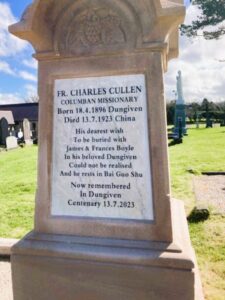
The grave in Dungiven where Fr Charles wanted to be buried.
Fr Neil Collins is from Co Derry. He was ordained in 1962 and served on mission in the Philippines. He is History Coordinator for the Columbans and the author of a number of books, including, ‘A Mad Thing to Do – A Century of Columban Missions (1916-2016)’.
This article is published in the July/August 2023 issue of the Far East magazine. Please subscribe here and support Columban missionaries: https://columbans.ie/product/far-east-magazine-yearly-subscription/
